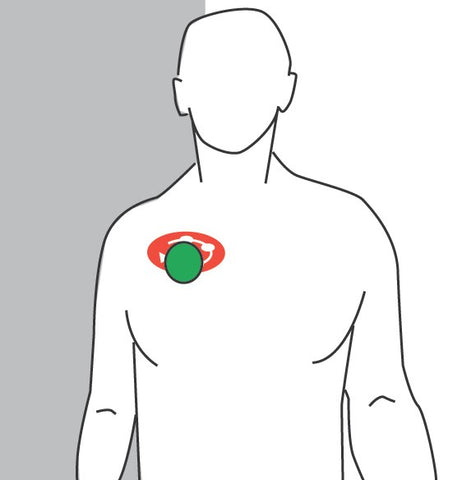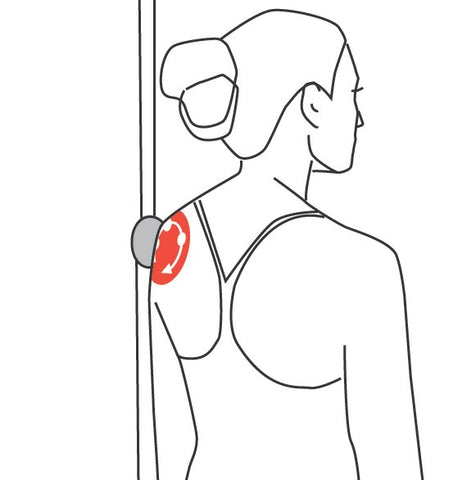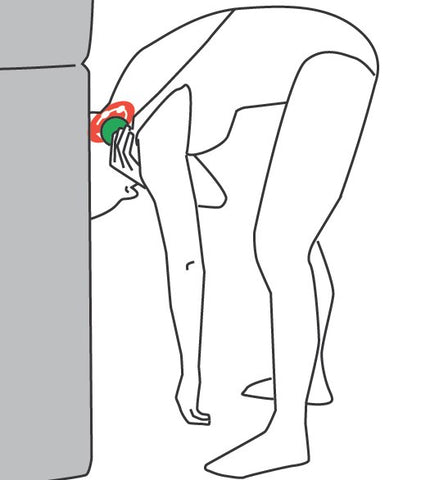Trigger Point Therapy - Self Help for Common Shoulder Pain
With thanks to Jeffrey Lutz CMTPT and Erica Carole LMT of the Pain Treatment and Wellness Center, Greenburg, PA
Whilst it's not usually a substitute for professional care, treating your own trigger points will often help to relieve painful symptoms
Treating your own trigger points isn't likely to provide the same outcome as you would get from treatment from a therapist, but it can be remarkably effective, and is something that we almost always prescribe for clients, between treatments.
Try first to use your fingers to apply pressure to the muscle, and to see if you can feel for a taut band or knot. Press with one finger on the exact spot and you should elicit pain (this can be local or referred).
Once you get used to the concept of treating trigger points, equipment such as hard balls and pressure tools can be used to amplify pressure and reduce stress on your fingers.
Pressure Tools
Pressure tools can be used standing, sitting, lying, or side lying. It is easy to overstimulate an active trigger point, so pressure should be applied slowly and gently until it is "just right."
You should hold the point until it softens or the pain yields. It is usually fine to use pressure tools up to six times a day, depending on the type and severity of the problem.
Follow these general instructions:
1. Identify the tender/trigger point you wish to work on.
2. Place the host muscle in a comfortable position, where it is relaxed and can undergo full stretch.
3. Apply gentle, gradually increasing pressure to the tender point until you feel resistance. This should be experienced more as discomfort and not as severe pain.
4. Apply sustained pressure until you feel the tender point yield and soften. This can take from a few seconds to several minutes.
5. Steps 3-4 can be repeated, gradually increasing the pressure on the tender/trigger point until it has fully yielded.
6. To achieve a better result, you can try to change the direction of pressure during these repetitions.
Be sensible
There are many reasons why you might have trigger points, so it is important to consider your trigger point pain in the context of the rest of your body. It must be stressed that the techniques offered on this page are not a substitute for therapy from a qualified practitioner.
Although aches and pains from trigger points are common, there can sometimes be an underlying pathology. It is advisable to always seek a proper diagnosis from a qualified medical practitioner or experienced manual therapist.
Stretching
If you are receiving any form of trigger point therapy, either self-help or with a therapist, it is advisable to stretch on the hour, every hour, on the day of the treatment and then three times per day thereafter for a few weeks to several months.
Self Help for shoulders ...
Pectoralis Major
Trigger points in this muscle may often be associated with mid-scapular back pain, thoracic outlet syndrome, anterior shoulder pain, golfer’s elbow and tennis elbow.

Infraspinatus
Trigger points in this muscle are often associated with decreased range of motion in "Apley Scratch" test (behind back), rotator cuff tendinopathy, frozen shoulder syndrome, pain in back and front of shoulder, night-time shoulder pain, dead-arm sensations, and “mouse arm” from computer mouse overuse.

Deltoid
Trigger points in this muscle are often associated with decreased range of motion (especially in abduction), shoulder pain which worsens with motion and eases at rest, and some loss of strength above 90 degrees.

Biceps
Trigger points in the biceps are typically associated with anterior shoulder pain with decreased arm extension, biceps tendonitis, reduced extension of arms, reduced "Apley Scratch" test manoeuvre, and frozen shoulder syndrome.

Supraspinatus
Trigger points in supraspinatus are common, and are often associated with loss of power in abduction, painful arc syndrome, subacromial bursitis, rotator cuff tendinopathy, deep aching at night, and clicking/snapping sounds in shoulder joint.

Find a Trigger Point Professional in your area
Dry Needling for Trigger Points
Certify as a Trigger Point Therapist
NAT Trigger Point Courses:
This trigger point therapy blog is intended to be used for information purposes only and is not intended to be used for medical diagnosis or treatment or to substitute for a medical diagnosis and/or treatment rendered or prescribed by a physician or competent healthcare professional. This information is designed as educational material, but should not be taken as a recommendation for treatment of any particular person or patient. Always consult your physician if you think you need treatment or if you feel unwell.
About Niel Asher Education
Niel Asher Education (NAT Global Campus) is a globally recognised provider of high-quality professional learning for hands-on health and movement practitioners. Through an extensive catalogue of expert-led online courses, NAT delivers continuing education for massage therapists, supporting both newly qualified and highly experienced professionals with practical, clinically relevant training designed for real-world practice.
Beyond massage therapy, Niel Asher Education offers comprehensive continuing education for physical therapists, continuing education for athletic trainers, continuing education for chiropractors, and continuing education for rehabilitation professionals working across a wide range of clinical, sports, and wellness environments. Courses span manual therapy, movement, rehabilitation, pain management, integrative therapies, and practitioner self-care, with content presented by respected educators and clinicians from around the world.
Known for its high production values and practitioner-focused approach, Niel Asher Education emphasises clarity, practical application, and professional integrity. Its online learning model allows practitioners to study at their own pace while earning recognised certificates and maintaining ongoing professional development requirements, making continuing education accessible regardless of location or schedule.
Through partnerships with leading educational platforms and organisations worldwide, Niel Asher Education continues to expand access to trusted, high-quality continuing education for massage therapists, continuing education for physical therapists, continuing education for athletic trainers, continuing education for chiropractors, and continuing education for rehabilitation professionals, supporting lifelong learning and professional excellence across the global therapy community.

Continuing Professional Education
Looking for Massage Therapy CEUs, PT and ATC continuing education, chiropractic CE, or advanced manual therapy training? Explore our evidence-based online courses designed for hands-on professionals.



















